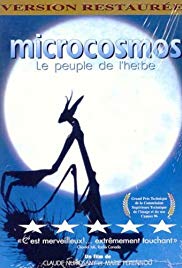1. Tell students that this class will be about symbiosis and predation. For students in the lower grades, define those terms. Tell students in the lower grades or elicit from class discussion the facts that bees pollinate more than flowers and that much of our food depends upon bees pollinating fruit trees, vegetable plants, and beans. Ask students to think about what the world would be like without oranges, apples, tomatoes and other fruits and vegetables.
2. Start playing the film from DVD Scene 1. TWM recommends playing the film to the end of clip #3 with brief stops for the introductions and closings recommended in this Guide or for class discussion. This has the advantage of exposing the class to the film’s introduction together with many short clips showing various insects. Playing the movie to the end of clip #3 takes about 22 minutes. You can also talk over this film; it has very little narration.
Introduction to Clip #1: As the clip begins ask students if they’ve ever seen a plant move on its own power in response to some stimulus from the environment.
This clip starts with time-lapse photography showing flowers opening. It lasts for a little more than two minutes and ends with a scene of a large tree surrounded by grass.
Closing for Clip #1: Tell students that the powdery material being placed onto the bees by the plants is pollen. It might be a good idea to run the DVD back for a few seconds to show this again.
3. Introduction to Clip #2: Tell students that aphids are small insects that eat plants and emit a sweet sticky substance called honeydew. Some species of ants use honeydew for food. Ants will tend the aphids and stroke them to encourage the aphids to give them some honeydew. Chemicals on the feet of the ants tranquilize and subdue the aphids. Ants will take aphids into their nests during cold weather, returning them to food plants when the weather warms. Ants will also transfer aphids to new feeding sites. Ants store excess honeydew in a separate stomach and regurgitate it for other ants when needed. Ladybugs eat aphids and many gardeners buy ladybugs to release into their gardens to kill aphids.
Clip #2 starts with a ladybug climbing up a plant stalk to clicking sounds and lasts about 2.5 minutes. It ends with ladybugs mating.
Closing for Clip #2: Ask students to identify the predatory or symbiotic relationships between bees and flowers and between aphids, ladybugs and ants. They should describe what the insects get, give or lose in each relationship. This can be in a quickwrite followed by a class discussion or it can simply be in class discussion. Diagram the flow of benefits on the board (or have a student do it). Then ask students to describe what the activity engaged in by the ants would be called if it was performed by a human being. Good responses will include farming, ranching, herding, or nurturing.
4. Introduction to Clip #3: Tell students that spiders keep the populations of other insects in check.
This clip starts as soon as the grasshoppers appear. They will soon fly into the spider’s web. Clip #3 itself lasts about two minutes. It ends when the film shows a hole which turns out to be an exit for winged ants.
Closing for Clip #3: Tell younger classes, if they don’t already know, that spiders eat by sucking the fluids from their prey.
5. Introduction to Clip #4: Tell the class that there are some plants that eat insects.
This clip begins at DVD Scene 9 and lasts for about three minutes. It ends with a Sundew enveloping a wasp.
Closing for Clip #4: Tell students that the second plant is called a Sundew. It has sticky glands on hairs which trap insects. The edges of the leaf then slowly roll over the prey as shown in the segment. These plants get their name from the glands on top of the hairs; they glisten like dew. Sundews are common in bogs and can occur on sandy banks and other mineral soils that are poor in organic nitrogen and phosphorus. The prey of the Sundew is used to supplement the nutrition that the plant gets through its roots. The glands at the end of the hairs produce digestive juices that decompose the prey. This process takes days and the maximum concentration of digestive enzymes is reached by the fourth day.
6. Beyond clip #4, as time allows, describe the additional examples of symbiosis found in the Supplemental Materials below.


